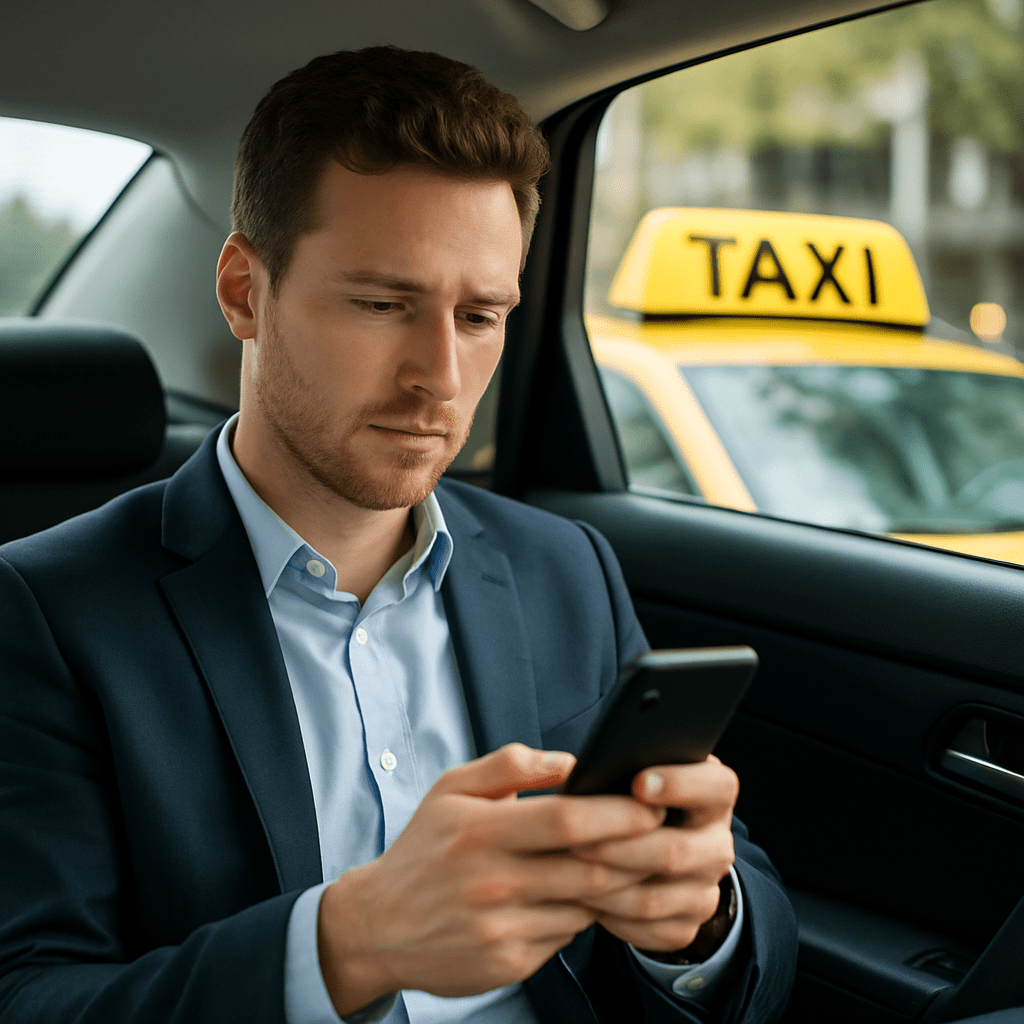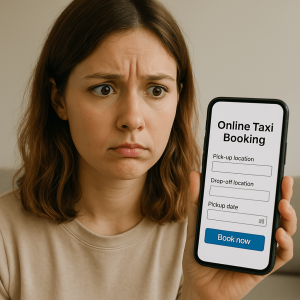Whether you’re a solo driver, run a small airport transfer company, or manage a full taxi fleet — all your bookings and revenue begin with just one thing: how customers book with you ( contact form or just whatsapp or modern dispatch software).
Out of 100 people who visit your website, message you, or get your contact from someone — how many actually complete a booking? Will it be 30? 50? Maybe 70? Or just 10?
In this article, we take a clear and honest look at three common booking methods that taxi businesses use today. We’ll break down the pros and cons of each one — and most importantly, show how many out of 100 people will likely finish the booking when using each method.
Option 1: Taking Bookings via WhatsApp
Today, WhatsApp is one of the most popular ways taxi businesses handle bookings. Many companies and independent drivers use it because it’s easy, requires no tech skills, and works instantly.
And yes — it is convenient:
- The client simply sends a message.
- You don’t need a website or system.
- You get the request and clarify details right away.
It’s as simple as: text – agree – go. But this simplicity hides some major problems that limit your growth.
When a client messages you on WhatsApp, they don’t see the price. They don’t know if you’re available. They wait. And if you’re busy, offline, or slow to respond — they just leave and look elsewhere. People today want to book fast and move on.
According to a study by MIT, published in Harvard Business Review, companies that contact potential clients within five minutes of receiving an inquiry are 21 times more likely to qualify that lead compared to those who wait 30 minutes.
There’s also the human factor: messages get lost, orders get mixed up, and everything depends on you personally. If we look at the numbers, only around 10–15 out of 100 people who contact you via WhatsApp will actually book. The rest? They don’t wait, change their mind, or go to a competitor with a more clear system.
This method might work:
- If you don’t have a website.
- If you’re working alone and don’t plan to hire dispatchers.
- If you’re not looking to grow and just handle what comes.
But let’s be honest — everyone wants to earn more. And that’s not possible when only 10 out of 100 potential clients complete a booking. Yes, WhatsApp is convenient — but it’s not effective if you want to scale.
Option 2: Booking via a Contact Form
The contact form on your website feels a bit more official.
Clients see a real site, a form, and it builds a sense of trust and professionalism.
It also works well for your business:
- You collect the necessary info upfront (route, time, contacts).
- You avoid repeating the same questions.
- Requests land in your inbox — so things feel structured.
But there’s a big catch: the client gets nothing immediately. They don’t see the price, don’t know who will respond or when and don’t know if the booking is confirmed. They just hit “Send” — and hear silence. And in 2025, silence is your biggest enemy.
On average, 40–50 out of 100 people will submit the form.
But unless you reply quickly — they’ll almost certainly leave. Even if you do respond, only 12–17 are likely to complete the booking — almost the same as WhatsApp.
And there’s another challenge: Clients often forget to mention something or change details later.
They may need a second child seat or extra luggage space. They write one thing, then call to change it — and now the booking needs to be fixed manually.
Most importantly, the group of clients who just want to book and go — they disappear instantly. They’re not interested in waiting. Now clients want a solution in one minute.
So yes — a contact form might be good:
- If you work with pre-bookings only.
- If you handle just a few orders and reply to everyone personally.
- If you can’t set up a full system yet — but want some structure.
Even then, someone must always be online. If you miss an email, skip a notification, or delay — that order is lost. A contact form is better than nothing. But it’s still far from what people expect when booking in today’s world.
Option 3: Online Booking with Dispatch Software Like CodiCo
This is the most modern and efficient method. It combines everything that matters — speed, trust, automation, and transparency.
What the client does:
- Enters pickup and drop-off addresses.
- Instantly sees the exact price based on distance, time, and car type.
- Chooses the car category.
- Adds extras — luggage, child seats, name sign, etc.
- Picks date and time.
- Gets instant confirmation on screen and by email.
What you get:
- A fully completed booking — no messaging, no errors.
- You see who booked, when, and where they’re going.
- The system sends reminders automatically — before and after the trip.
- Bookings are assigned to available drivers automatically.
- You get trip history, reports, and filters.
It saves time, removes human error, and builds trust — because everything is clear, fast, and professional. And most importantly — 70–95 out of 100 people complete a booking this way. Because they see all the info they need right away and can decide with confidence. It respects their time. It shows professionalism. Isn’t that exactly what every taxi or transfer business owner wants?
A system where the client:
- Calculates their own fare,
- Chooses the right car,
- Adds details,
- And the system confirms, schedules, and reminds — without your involvement.
Yes, it takes a day or two to set up. But after that:
- You don’t lose bookings.
- You don’t go back and forth with every client.
- You don’t waste time on calculations.
- You don’t forget about returning clients.
Dispatch software isn’t just another digital tool — it’s a way to run your business at a higher level. It’s what separates growing companies from those just “getting by.”
Comparison Table: Which Booking Method Works Best: Dispatch Software or other forms?
| What matters | Contact form | Online booking via Dispatch Software | |
|---|---|---|---|
| Client sees the price immediately | ❌ No | ❌ No | ✅ Yes |
| Online payment available | ❌ No | ❌ No | ✅ Yes |
| Automatic confirmation | ❌ No | ❌ No | ✅ Yes |
| Time to book | ⏳ 5–15 minutes | ⏳ Up to several hours | ✅ 1–2 minutes |
| Booking without back-and-forth texting | ❌ No | ❌ No | ✅ Yes |
| Accurate booking information received | 🟡 Partially | 🟡 Partially | ✅ Fully |
| Risk of losing the client | 🔴 High | 🔴 Very high | 🟢 Minimal |
| Possibility of repeat bookings | ❌ No | ❌ No | ✅ Yes |
| Bookings out of 100 clients | 10-15 | 12-17 (if answered quickly) | 70–95 |
Final Thoughts: Start Where It Really Matters
Everything starts not with the car or driver — but with how the client makes the decision to book.
If that moment is confusing, slow, or unclear — they simply don’t book. You’re losing money not because your drivers are bad or your prices are too high. But because your booking process isn’t convenient enough.
When booking is easy, quick, and clear — people stay. Because it shows professionalism. It saves their time. And that becomes your advantage.
It might seem like solutions like this are only for big companies. But often, that’s exactly the problem — your business isn’t growing because you’re still using tools that don’t let it grow. Wouldn’t it be better to get 70 bookings out of 100 client inquiries, instead of just 10–17?
Setting up a dispatch system takes just 1–2 days — and you can start seeing results within the first week.
Dispatch software won’t bring you new clients on its own. But it will help you stop losing the ones who already found you. It will help you organize requests, speed up your replies, remove human errors, and show that your service is easy to use.
You can always see how it works — a free demo CodiCo Dispatch Software is available. You might realize how much easier this could make things for both you and your clients.

 Subscribe
Subscribe







